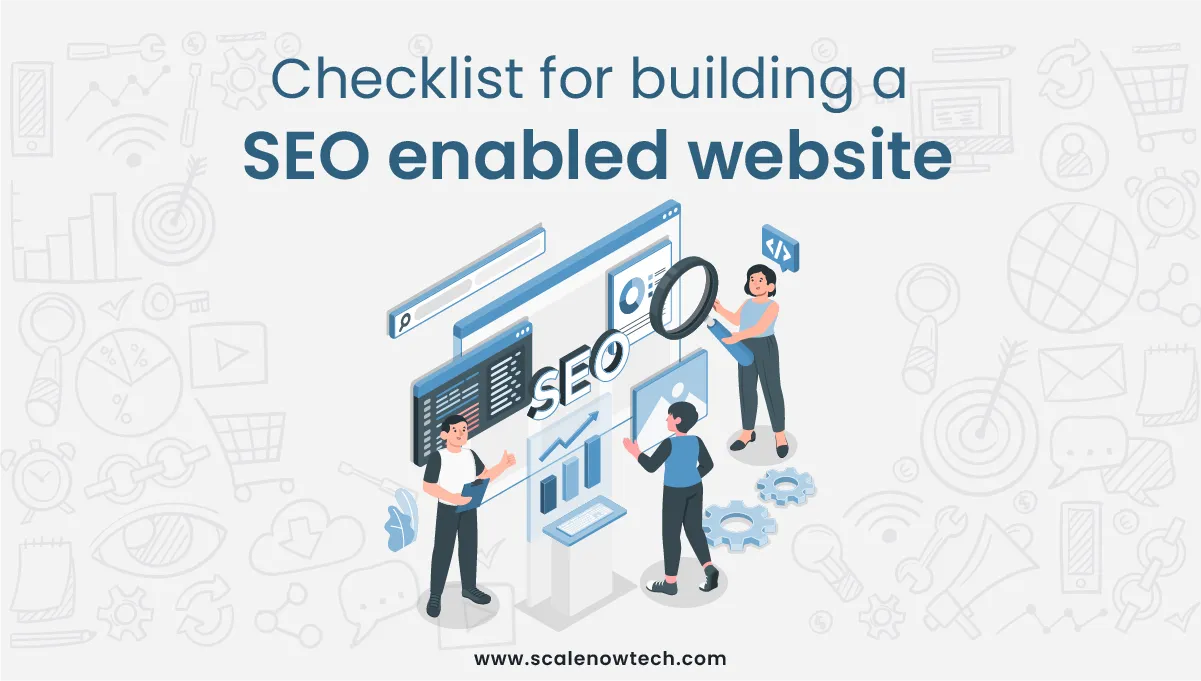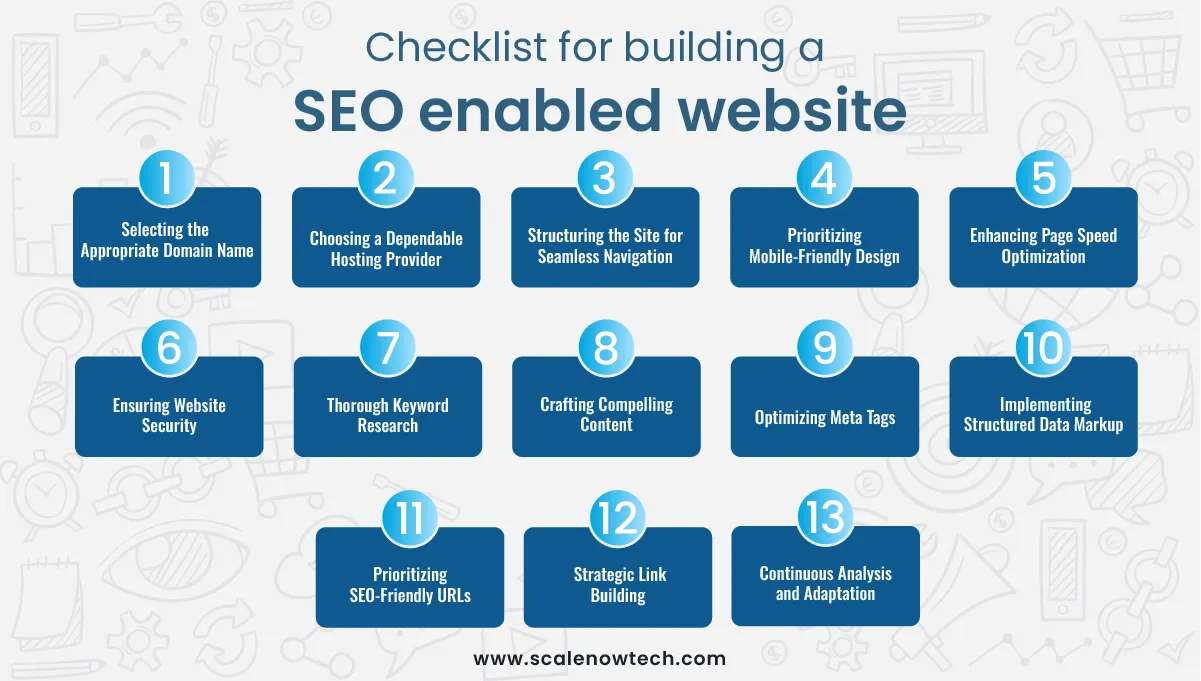
Ultimate Checklist for Building a SEO Enabled Website
Discover the ultimate SEO checklist for building your custom website with expert guidance from Scalenowtech. Optimize your online presence efficiently!

Checklist for building a SEO enabled website
Welcome to Scalenowtech! As specialists in website development, we understand that building a website isn’t just about slick design and innovative functionality—it’s also crucial to ensure your website is optimized for search engines right from the start.
(SEO) Search Engine Optimization isn’t a mere addition to your website; it’s a foundational component that affects your visibility online and, ultimately, your success. Here's our comprehensive checklist for building an SEO-enabled website that ranks well and reaches your target audience effectively.

1. Selecting the Appropriate Domain Name
Relevance is Key: Opt for a domain name that accurately represents your business or services offered, reinforcing your brand identity and aiding in SEO.
Memorability Matters: Opt for a concise, memorable domain name to facilitate easy recall by potential visitors.
Avoid Hyphens and Numerals: Steering clear of hyphens and numbers reduces confusion for both users and search engines.
2. Choosing a Dependable Hosting Provider
Prioritize Uptime: Seek hosting services boasting high uptime guarantees (99.9% and above) to ensure uninterrupted website availability.
Speed Considerations: Hosting speed significantly impacts website load times, a crucial factor influencing SEO and user experience.
Strategic Server Location: Opt for a server location proximate to your target audience to expedite data delivery and enhance user experience.
3. Structuring the Site for Seamless Navigation
Establish a Logical Hierarchy: Arrange content in a logical manner, ensuring a straightforward URL structure and intuitive navigation paths for enhanced user and search engine accessibility.
Utilize Breadcrumbs: Employ breadcrumbs to aid users in understanding their position within the website's hierarchy and facilitate easy navigation back to previous pages.
4. Prioritizing Mobile-Friendly Design
Embrace Responsive Design: Ensure optimal website performance across all devices, particularly mobiles, aligning with Google's mobile-first indexing approach.
Enhanced Touch Screen Usability: Optimize button and link placement for effortless touch interaction and seamless navigation on touchscreen devices.
5. Enhancing Page Speed Optimization
Efficient Image Compression: Employ image compression tools to reduce file sizes without compromising quality, enhancing website loading speed.
Code Minimization: Streamline CSS, JavaScript, and HTML coding to minimize website load times.
Browser Caching Utilization: Leverage browser caching mechanisms to store frequently accessed data locally, accelerating subsequent page loads.

6. Ensuring Website Security
SSL Certificate Implementation: Secure your website with HTTPS encryption, signaling to users and search engines that their data is protected and positively impacting SEO rankings.
Regular Maintenance: Keep your content management system (CMS), plugins, and scripts updated to mitigate potential security vulnerabilities and maintain website integrity.
7. Thorough Keyword Research
Relevance-driven Keyword Selection: Identify pertinent keywords aligned with your content and audience preferences to optimize search engine visibility.
Incorporating Long-Tail Keywords: Integrate long-tail keywords for targeted optimization, leveraging their lower competition and enhanced relevance.
Strategic Keyword Placement: Strategically embed keywords within titles, headers, and content to bolster SEO efficacy.
8. Crafting Compelling Content
Value-Centric Approach: Develop content that addresses user queries, resolves issues, or provides valuable insights, fostering user engagement and trust.
Structured Content Organization: Utilize hierarchical header tags (H1, H2, H3) for clear content organization, enhancing both readability and SEO performance.
Regular Content Updates: Maintain content freshness through regular updates, encouraging user revisits and signaling relevance to search engines.
9. Optimizing Meta Tags
Unique Title Tags: Craft unique title tags for each page, incorporating primary keywords to enhance search engine visibility.
Compelling Meta Descriptions: Create engaging meta descriptions to entice clicks and drive traffic, influencing click-through rates and user engagement.
10. Implementing Structured Data Markup
Leveraging Schema Markup: Integrate schema markup to provide search engines with context-rich data, potentially leading to improved rankings and enhanced search result presentations.
11. Prioritizing SEO-Friendly URLs
Clarity in URL Structure: Opt for clear and concise URLs containing relevant keywords, aiding both user comprehension and search engine indexing.
Length Considerations: Keep URLs succinct to convey information effectively while avoiding unnecessary complexity.
12. Strategic Link Building
Internal Linking Strategy: Strategically interlink pages within your website to distribute link equity and facilitate content discovery for users and search engines.
Acquiring Backlinks: Cultivate backlinks from reputable sources within your industry to bolster website credibility and improve search engine rankings.
13. Continuous Analysis and Adaptation
Utilizing Analytical Tools: Employ tools such as Google Analytics to monitor website traffic and user behavior, facilitating data-driven decision-making.
Regular SEO Audits: Conduct periodic SEO audits using tools like SEMrush, Ahrefs, or Moz to identify optimization opportunities and enhance website performance over time.
Building an SEO-enabled website is not a one-time task but a continuous process. At Scalenowtech, we emphasize the importance of not only incorporating SEO at the building stage but also continuously optimizing and updating according to the latest search engine algorithms and trends.
This approach ensures that your website not only reaches its audience but also delivers on the goals it sets out to achieve. Ready to scale up your digital presence? Let’s get started!
Related Blogs
Coming soon...
.85bbfc68.png&w=640&q=75)

.0df94cc1.png&w=256&q=75)

